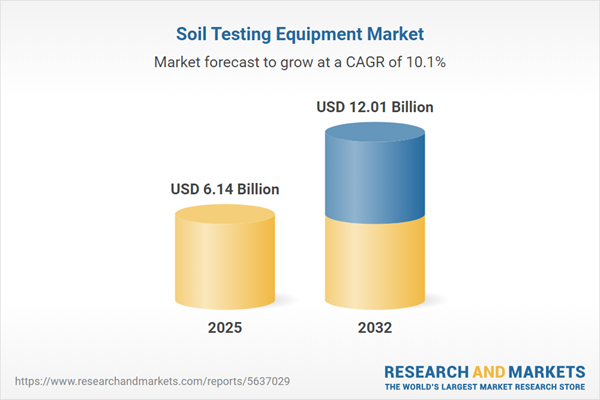Speak directly to the analyst to clarify any post sales queries you may have.
The soil testing equipment market serves as a critical enabler of productivity improvement, regulatory compliance, and sustainability for agriculture, environment, and industry. This report equips senior leadership with targeted insights to inform investment strategies and operational planning in this fast-evolving sector.
Market Snapshot: Soil Testing Equipment Market Growth and Dynamics
The Soil Testing Equipment Market grew from USD 5.56 billion in 2024 to USD 6.14 billion in 2025 and is projected to reach USD 12.01 billion by 2032, at a CAGR of 10.09%. This growth reflects expanding adoption across agricultural, environmental, and industrial applications, underpinned by continuous technological innovation and intensifying sustainability requirements. Evolving customer needs, regulatory shifts, and rising demand for portability and data connectivity are driving rapid changes in both equipment and business models.
Scope & Segmentation: Understanding Core Market Dimensions
This research delivers detailed coverage across major segments and geographic regions, empowering decision-makers to prioritize opportunities by business line and market presence:
- Equipment Type: Field portables include portable spectrometers and sensor kits designed for immediate on-site analysis. Laboratory instruments encompass chromatography platforms, ion selective electrode analyzers, and spectroscopy systems for comprehensive chemical assessments.
- Technology: Core methodologies profile chromatography, ion selective electrodes, sensor-based solutions, and spectroscopy, each offering distinct advantages in sensitivity, throughput, and field or lab deployment.
- Application: The market addresses agricultural testing for nutrient optimization, environmental monitoring for contaminant detection, and industrial analysis for substrate compliance and waste management.
- End User: Segments include agriculture producers seeking operational efficiency, contract laboratories requiring high-volume precision, environmental agencies enforcing standards, and research institutes advancing scientific agendas.
- Geographical Coverage: Analysis spans the Americas (including North America, Latin America), Europe, Middle East & Africa, and Asia-Pacific regions. Key sub-regions such as the United States, China, Germany, and India are included.
- Company Profiles: The report examines recent developments and strategic moves from Thermo Fisher Scientific Inc., Agilent Technologies, PerkinElmer, Shimadzu Corporation, Metrohm AG, Mettler-Toledo International, HORIBA Ltd., Beckman Coulter Life Sciences, Hach Company, and Waters Corporation.
Key Takeaways: Strategic Insights for Senior Decision Makers
- Miniaturization and modularity are making advanced soil diagnostics accessible directly at sampling sites, facilitating faster in-field decision-making.
- Integration of cloud-based analytics and IoT-enabled sensors allows continuous monitoring, shifting soil testing from periodic analysis to real-time management.
- Collaboration between large manufacturers and technology specialists is accelerating the development of user-friendly, subscription-based, and service-driven offerings.
- Strong investment and regulatory frameworks in North America and Europe are fostering adoption of both portable and lab-based solutions, while Asia-Pacific’s modernization is driving high growth in integrated field-lab equipment.
- Environmental regulations and the push for sustainable agriculture are increasing demand for comprehensive soil quality management across public and private sectors.
- The competitive landscape is defined by innovation in analytics software, modular platforms, and lifecycle management services, supporting a diverse range of user needs.
Tariff Impact: Navigating Policy Changes and Cost Pressures
Recent United States tariffs on electronic components, sensor modules, and high-precision instrumentation have introduced new challenges for supply chains and procurement planning. Firms are responding with nearshoring strategies and increased domestic production, aiming to maintain supply resilience and mitigate volatility in capital and operational budgets. These dynamics are influencing sourcing decisions and driving greater interest in managed services to maintain cost predictability and operational continuity.
Methodology & Data Sources
This report is grounded in a rigorous methodology combining primary interviews with sector executives and technical experts, as well as secondary analysis of peer-reviewed publications, trade databases, and regulatory filings. Data triangulation ensures insight quality and transparency for critical decision-making.
Why This Report Matters: Actionable Intelligence for Leadership
- Enables senior executives to anticipate technology, regulatory, and market changes impacting core business lines.
- Supports effective allocation of R&D, supply chain, and commercial resources by illuminating high-growth segments and geographies.
- Guides risk mitigation strategies in response to evolving tariff and procurement landscapes.
Conclusion
Continuous innovation in soil testing equipment is reshaping operational models and competitive positioning across agriculture, environment, and industry. This report provides a strategic framework for navigating complexity and capitalizing on emerging opportunities in a dynamic market.
Additional Product Information:
- Purchase of this report includes 1 year online access with quarterly updates.
- This report can be updated on request. Please contact our Customer Experience team using the Ask a Question widget on our website.
Table of Contents
3. Executive Summary
4. Market Overview
7. Cumulative Impact of Artificial Intelligence 2025
Companies Mentioned
The companies profiled in this Soil Testing Equipment market report include:- Thermo Fisher Scientific Inc.
- Agilent Technologies, Inc.
- PerkinElmer, Inc.
- Shimadzu Corporation
- Metrohm AG
- Mettler-Toledo International Inc.
- HORIBA Ltd.
- Beckman Coulter Life Sciences, Inc.
- Hach Company
- Waters Corporation
Table Information
| Report Attribute | Details |
|---|---|
| No. of Pages | 194 |
| Published | October 2025 |
| Forecast Period | 2025 - 2032 |
| Estimated Market Value ( USD | $ 6.14 Billion |
| Forecasted Market Value ( USD | $ 12.01 Billion |
| Compound Annual Growth Rate | 10.0% |
| Regions Covered | Global |
| No. of Companies Mentioned | 11 |









